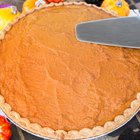
In midsummer, when the weather is hot and even the kids don't want to move, heavy desserts lose much of their appeal. That's when lemon fillings, with their light and refreshing acidity, come into their own. There are several ways to thicken a lemon filling, depending how it'll be used.
Thickened With Eggs
The traditional way to thicken an lemon filling for pies and tarts is with eggs. When you whisk the beaten egg into your lemon filling, you're spreading the egg white's proteins throughout the sweetened lemon juice mixture. When you place that mixture over a double boiler and stir it, the egg proteins begin to warm. When they begin to set -- just as they do in a fried egg -- they create a three-dimensional web of protein strands, trapping the filling's moisture and creating a soft, gel-like consistency. This kind of filling can't be baked or the eggs will overcook and separate, but it's good in a pie or cooled and spread on cakes as a filling.
Thickened with Cornstarch
Starchy thickeners work well with lemon juice. One of the most widely available options is cornstarch, which has the dual advantages of being inexpensive and easy to use. It also leaves your filling clear and glossy, which sometimes means you'll need to add food coloring or other ingredients to make it yellower. To use cornstarch as your thickener, heat the sweetened lemon mixture until it simmers. Whisk the cornstarch into a small amount of cold water, and stir it briskly into your filling. Within a minute or two, it will thicken. Cornstarch fillings can be baked, but the acidity will make them break down after a day or two.
Thickened with Other Starches
Arrowroot, tapioca and the special "waxy" cornstarch used by professional bakers are less common than regular cornstarch, but they can be used in much the same way. Arrowroot thickens at about the same temperature as cornstarch, and tapioca at a slightly lower temperature. Both tapioca and arrowroot can have a lightly stringy texture, so they're best used in fillings for smaller pastries. Fillings made with arrowroot or "waxy" cornstarch can be baked; they'll also freeze and thaw without breaking down.
Thickened with Gelatin
Gelatin works to thicken a filling, or to stabilize a filling that's been thickened with eggs or starch. Sprinkle the gelatin over a small amount of cold water, and wait as it absorbs the water and "blooms." When the gelatin has absorbed the water, stir it into your hot filling until it's thoroughly mixed. Pour the hot filling into your pastries, or let it cool to room temperature and whip it before it's completely set. You can also lighten the filling at this stage by folding in whipped cream, or a meringue of cooked or pasteurized egg whites.
Related Articles
A Substitute for Meringue

Help: How Can I Thicken Lemon Icebox ...

How to Fix Grainy Whipped Ganache

Can You Use Konjac Flour in Baking?

Custard vs. Pastry Cream

What Can I Substitute for Cornstarch?

Sugar-Free Coconut Cream Pie

Can I Substitute Quick Cooking Tapioca ...

Heavy Whipping Cream Vs. Half & Half

How to Keep Lemon Pie From Turning ...

How to Make Pineapple Empanadas

Can You Reheat Tapioca?

Substitute for Manioc Starch

Can You Make a Great Tiramisu Without ...

Baking Soda or Baking Powder to Make a ...

How to Harden Up Whipped Cream

How to Boil Blackberries & Sugar for a ...
Can I Use Flour Instead of Cornstarch ...

How Do I Thicken Blueberries to Make ...

How to Make Pumpkin Pie
References
- The Professional Pastry Chef; Bo Friberg
- On Food and Cooking: The Science and Lore of the Kitchen; Harold McGee
Writer Bio
Fred Decker is a trained chef and certified food-safety trainer. Decker wrote for the Saint John, New Brunswick Telegraph-Journal, and has been published in Canada's Hospitality and Foodservice magazine. He's held positions selling computers, insurance and mutual funds, and was educated at Memorial University of Newfoundland and the Northern Alberta Institute of Technology.
Photo Credits
Jupiterimages/Photos.com/Getty Images